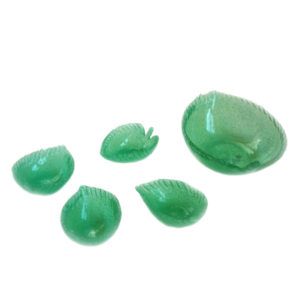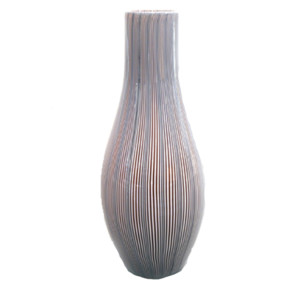(1906-1978)
Carlo Scarpa is widely recognized one of the most important architects and glass makers of the twentieth century. He was born in Venezia, Italy in 1906. His first projects spanned the years 1922-1924, when he collaborated with the architect V. Rinaldo. Scarpa then attended the Royal Academy of Fine Art in Venice, and acquired his diploma of Professor in Architectural Drawing in 1926.

While architecture was Scarpa’s main focus, he was also very interested in glass making. During the 1920s, Scarpa created his first pieces while working for Cappelin. He later became the artistic director of Venini from 1933 to 1947. Venini was one of the most important Venetian glass makers during this time, and Scarpa’s natural understanding of raw 
Many of the techniques that he pioneered were very difficult technically, which is one of the reasons that they command high prices. Working with glass of different colors is difficult, as each color has its own co-efficient of expansion, and reacts to heat differently. The battutto, in which the surface is hand-worked to create a “hammered” texture, was difficult, as the pattern had to be carefully controlled, and the pressure could easily cause a piece to break. This was an important technique that Scarpa pioneered in 1940. Filigrana, another important technique, involves spiraling very thin strands of glass onto an already blown form – the strands had to be perfectly spaced.
The murrine technique is a very ancient one, and involved first forming the “murrines” -rods containing different colors of glass in specific colors into a specific pattern, which could be flowers, faces, or the abstract geometric motifs that Scarpa favored. These rods were then cut into thin sections. Melding these slices seamlessly was challenging, as was forming the actual piece. The extreme thinness of his pieces made the work even more difficult technically. Usually, the finished pieces were given a very fine battutto finish. This process of blowing glass to extreme thinness was called soffiati. His murrine pieces are, perhaps, his most important achievement. When translucent glass was used, the effect is like a stained-glass window. When opaque glass, sometimes referred to as pasta vitreo was used, the resulting pieces look as if carved from some kind of magical wood.
Another important and difficult technique used by Scarpa was tessuto, in which very thin canes of glass of different colors were fused, and then the vase was blown very thin. The rods had to form perfect vertical lines – any pieces that were not perfect were discarded. Sometimes, the surface was left shiny, and for some pieces, it was subjected to battutto for added texture, and a matte finish.

Scarpa also designed glass with very simple forms, known as Cinese, as they were influenced by the shapes of Chinese ceramics. These pieces were richly colored, and had a shiny finish, almost like glazed ceramic. Occasionally, he would give these pieces a very fine battutto finish, resulting in a velvety surface known as velato.

Throughout all of his various projects, Scarpa never lost his passion for teaching. He continued to be a part of the faculty at Venice’s Istituto Universitario di Architettura, and from 1954 to 1964, he taught every year to Fulbright scholars in Rome.
Scarpa’s won many awards for his work and his many achievements. One of the awards he was given was the National Olivetti Award for Architecture, which he won in 1956. Also in 1956, Scarpa designed a series of glass for I.V.R Mazzega. He was also awarded with the IN-ARCH National Award for Architecture for the Castelvecchio Museum of Verona, in 1962, for his accomplishments in the field of architecture.
Carlo Scarpa died in 1978 in an unfortunate accident while visiting Japan. His son, Tobia, continued to design and make very interesting glass. Carlo Scarpa will always be remembered as one of the most important architects and glass makers of the Twentieth Century, and his innovative techniques still influence the work of artists today.
Showing all 2 results



